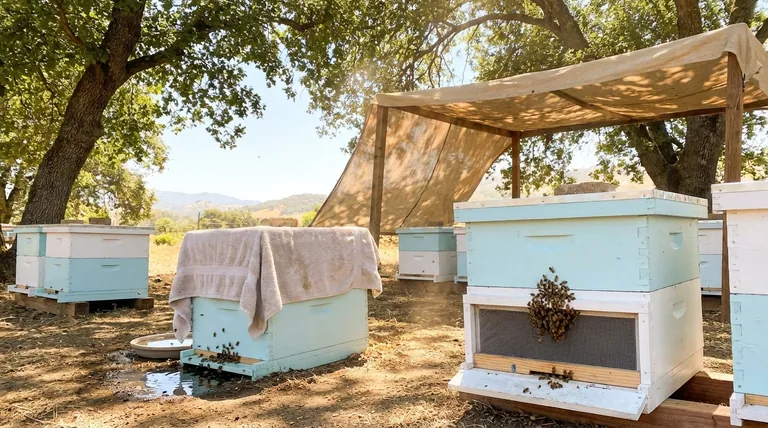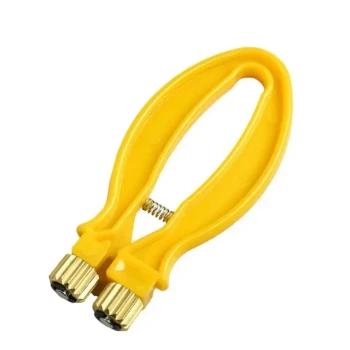In extreme heat, the most effective supplemental cooling techniques for beehives involve supporting the colony's natural cooling mechanisms. These methods include enhancing ventilation, providing shade, using evaporative cooling like wet towels or misters, and reducing the hive's solar absorption by painting it a light color.
Your goal is not to replace the bees' own sophisticated cooling system, but to reduce the environmental burden on it. The best interventions support the bees' natural efforts without causing additional stress or introducing excessive moisture into the hive.

Understanding the Bee's Natural Air Conditioning
Before intervening, it's critical to understand how a honeybee colony cools itself. Bees are masters of thermoregulation, but extreme conditions can overwhelm their capacity.
The Role of Water Collection
Worker bees will forage for water instead of nectar during a heatwave. They bring this water back to the hive and spread it on the surfaces of the comb.
The Power of Fanning
Other bees then station themselves at the hive entrance and throughout the interior, fanning their wings in a coordinated effort. This creates airflow that evaporates the water, creating a powerful swamp-cooler effect that lowers the internal temperature.
The Behavior of Bearding
You may see a large number of bees congregating on the front of the hive, forming a living "beard." This is a natural behavior to reduce the number of bodies inside the hive, which lowers the internal heat load and improves air circulation for the fanning bees.
Proven Supplemental Cooling Strategies
Your actions should focus on making the bees' jobs easier. The most effective strategies are often the simplest.
Maximize Passive Ventilation
Proper airflow is the single most important factor. A stuffy hive is a hot hive.
Ensure you have a screened bottom board fully open. You can also add an upper entrance or prop the outer cover up slightly with a small stick or shim to allow hot air to escape.
Provide Afternoon Shade
A hive sitting in direct, intense afternoon sun is under enormous thermal stress.
Positioning hives to receive morning sun and afternoon shade is the ideal long-term solution. For existing hives, use a patio umbrella, a sheet of plywood, or shade cloth to block the harshest sun.
Use Evaporative Cooling (Carefully)
This directly supports the bees' own water-fanning method.
Place a wet, light-colored towel over the top of the hive, ensuring it doesn't block the entrance. As the water evaporates, it will draw heat away from the hive body. A misting system can be used nearby, but never spray it directly into the hive entrance.
Reduce Solar Gain
Dark colors absorb heat, while light colors reflect it.
Painting your hive bodies and outer covers white or a very light pastel color significantly reduces how much heat the woodenware absorbs from the sun.
Understanding the Trade-offs and Risks
Improper cooling techniques can do more harm than good. Understanding the potential downsides is key to effective intervention.
The Danger of Excess Humidity
The biggest risk with wet towels and misters is raising the internal hive humidity too high. Bees need to dehydrate nectar to make honey, and high humidity makes this process much more difficult.
Never drench the hive or allow water to pool at the entrance. The goal is surface evaporation, not saturation.
The Problem with Fans
While a fan might seem like a good idea, it can be disruptive.
A fan pointed at the entrance can disorient returning foragers and interfere with the pheromone signals bees use to communicate. It can also disrupt the bees' own carefully coordinated fanning efforts.
Avoid Unnecessary Hive Inspections
Opening the hive during a heatwave breaks the colony's "propolis seal" that helps regulate airflow. It also causes significant stress, forcing the bees to re-establish their internal climate control when they are already working overtime.
Making the Right Choice for Your Goal
Select your strategy based on whether you are preparing for future heat or reacting to a current crisis.
- If your primary focus is long-term preparation: Position your hives for afternoon shade, paint them a light color, and ensure you have a screened bottom board for ventilation.
- If your primary focus is emergency cooling during a heatwave: Provide temporary shade immediately and use a damp towel over the hive cover, allowing it to dry out between applications.
Ultimately, a healthy, populous colony with access to a nearby water source is your best defense against heat.
Summary Table:
| Supplemental Cooling Technique | Key Benefit | Important Consideration |
|---|---|---|
| Maximize Ventilation | Reduces internal heat and humidity buildup. | Use screened bottom boards and upper entrances. |
| Provide Afternoon Shade | Shields hive from intense solar radiation. | Ideal for long-term hive placement. |
| Use Evaporative Cooling | Directly supports bees' natural cooling efforts. | Avoid excess moisture inside the hive. |
| Paint Hive a Light Color | Reflects sunlight to reduce solar heat absorption. | A simple, long-term preventive measure. |
Keep your apiary productive and your colonies healthy through the hottest months. HONESTBEE supplies durable, high-quality beekeeping supplies and equipment—like screened bottom boards and light-colored hive bodies—designed to help commercial apiaries and distributors manage extreme weather effectively. Contact our experts today to discuss wholesale solutions tailored for your operation's climate challenges.
Visual Guide

Related Products
- Inner Beehive Cover for Beekeeping Bee Hive Inner Cover
- Professional Insulated Winter Hive Wrap for Beekeeping
- Professional Galvanized Hive Strap with Secure Locking Buckle for Beekeeping
- Long Langstroth Style Horizontal Top Bar Hive for Wholesale
- Premium Comfort Grip Spring-Loaded Hive Handles
People Also Ask
- What is the recommended orientation for the rim of an inner cover? Master Hive Ventilation and Insulation
- What is the role of inner covers in insulated beehives? Master Moisture Control for a Healthy Colony
- What are the advantages of using an inner cover in a beehive? Key Benefits for Hive Health & Beekeeper Efficiency
- What is the role of the inner cover in a beehive? Essential Climate Control for Hive Health
- What is the function of an inner cover in a beehive? Essential for Hive Health & Management



















